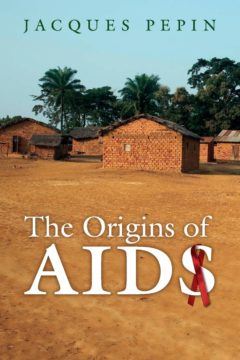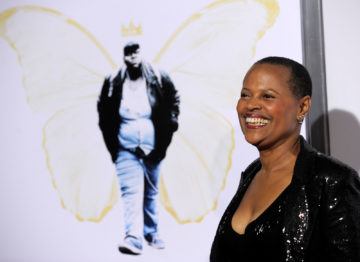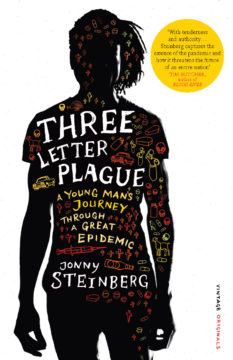by Claire Chambers
 Covid-19 has led to various reactions akin to the various phases in the process of grieving. Davide Bertorelli observes in his chapter for The World Before and After Covid that ‘people have experienced differing degrees of anxiety, panic and disruption in every aspect of their lives’. Given what Bertorelli calls our current ‘mild collective psychosis’, it behoves us to learn from the previous global pandemic, the HIV/AIDS crisis.
Covid-19 has led to various reactions akin to the various phases in the process of grieving. Davide Bertorelli observes in his chapter for The World Before and After Covid that ‘people have experienced differing degrees of anxiety, panic and disruption in every aspect of their lives’. Given what Bertorelli calls our current ‘mild collective psychosis’, it behoves us to learn from the previous global pandemic, the HIV/AIDS crisis.
HIV is a virus that contains single-stranded ribonucleic acid (RNA), as does SARS-CoV-2. Transmission is by blood-borne infection through bodily fluids: blood, semen, and saliva. Typical routes are via sex, needles for intravenous drugs or blood transfusions, or vertical transmission from mother to baby. Like all viruses, HIV (human immunodeficiency virus) gets taken up into the host’s cells, mostly the white CD4 T cells. The virus then uses the host’s equipment to reproduce its own RNA. After killing off the helper T cells, HIV bequeaths the host an immunodeficiency.
HIV infections have three different phases. First is the primary infection stage, known as seroconversion, when the disease is caught. It usually takes seven to 21 days for patients to show the illness in flu symptoms and a rash. Then they get better and the virus lies dormant, possibly for years. The second phase is persistent generalized lymphadenopathy: carriers manifest swollen glands for quite some time but are otherwise healthy. The third phase is acquired immune deficiency syndrome itself, where patients develop an AIDS-defining illness. Opportunistic infections such as aspergillosis, cryptococcosis, candidiasis, toxoplasma, and cryptosporidium have famously been devastating for people with AIDS. Their immune systems cannot cope, whereas healthy people can easily fight off such infections. In addition to the AIDS-defining illness, the other characteristic of AIDS is that sufferers have a low CD4 count.
Given that the Covid-19 vaccine was developed and approved in just over twelve months from the virus’s emergence, it is extraordinary that more than 40 years into the AIDS crisis there is still no vaccine for HIV. Scientists in Oxford are working on one, called HIVconsvX, but trials are still in their early days. Perhaps this is because, unlike coronavirus – ‘humankind’s common enemy’ – AIDS was derogatively seen as a marginal disease of the four Hs: homosexuals, haemophiliacs, heroin addicts, and Haitians (with additional damaging worries in medical circles about health workers and house officers). As a result, for years the HIV virus was sidelined and stigmatized.
These days, as well as various phases of the disease there are also different phases of treatment for AIDS. Controversial among right-wingers, pre-exposure prophylaxis is designed to prevent HIV infection among high-risk groups. Alternatively, a person who thinks they may have contracted the virus can take post-exposure prophylaxis until they get their test result after about three months. Finally, a person with HIV should take antiretroviral drugs every day, which now confers a normal life expectancy for those privileged enough to have access to the therapy. When these ARVs were pioneered in America in 1996, doctors spoke in wonderment at the so-called Lazarus effect. Sufferers at death’s door soon rose from sick beds and went back to their business, looking and feeling perfectly well. There have also been a few instances of stem cell transplants ‘curing’ people with AIDS.
But HIV/AIDS has been vastly more devastating than Covid. In those early years it was untreatable and incurable. It is estimated that some 33 million people around the world have died from AIDS-related illnesses. Due to overpriced medication and stretched or even entirely absent healthcare systems as consequences of (neo-)colonialism, people continue to die unnecessarily of the virus in Africa.
 HIV’s origins are as a zoonotic disease that was transmitted by the chimpanzee to humans, probably in the then-Germany colony of Cameroon during the early twentieth century. For a long time there was a theory mired in racist tropes that was known as the ‘cut hunter’ hypothesis. The story went that an African killed a chimp for its meat, and that this lentivirus then entered his bloodstream through minor wounds on his body sustained in the rainforest. Yet in his book The Origins of AIDS, Jacques Pepin debunks this theory. Pepin demonstrates that the indigenous people of this region were subsistence hunters and had a cultural prohibition against chimp meat. But after the First World War, Britain and France shrugged the German colonizers aside. The cut hunter is in fact likely to have been an African forcibly conscripted to fight against his own interests in this imperial war and to kill primates in contravention of his taboo.
HIV’s origins are as a zoonotic disease that was transmitted by the chimpanzee to humans, probably in the then-Germany colony of Cameroon during the early twentieth century. For a long time there was a theory mired in racist tropes that was known as the ‘cut hunter’ hypothesis. The story went that an African killed a chimp for its meat, and that this lentivirus then entered his bloodstream through minor wounds on his body sustained in the rainforest. Yet in his book The Origins of AIDS, Jacques Pepin debunks this theory. Pepin demonstrates that the indigenous people of this region were subsistence hunters and had a cultural prohibition against chimp meat. But after the First World War, Britain and France shrugged the German colonizers aside. The cut hunter is in fact likely to have been an African forcibly conscripted to fight against his own interests in this imperial war and to kill primates in contravention of his taboo.
Colonialism and this hapless soldier are HIV’s real Patient Zero, and not the promiscuous French-Canadian flight attendant Gaëtan Dugas (1953–1984). Dugas, a good-looking and hard-partying traveller, was posthumously and pruriently exposed by a homophobic media as the Typhoid Mary of the AIDS era. However, in his book Patient Zero and the Making of the AIDS Epidemic, Richard A. McKay refutes the media’s scurrilous claims, following Randy Shilts, that Dugas was the 1970s and 1980s super-spreader who carried HIV from coast to coast in North America, as well as to Europe and back again. Though it is easy to point the finger at this out and proud sexual adventurer, Dugas’s vilification has much to do with how open he was in interviews with AIDS researchers.
As Dugas’ dates suggest, AIDS came to global attention in the early 1980s with the discovery of a rare disease in young gay men in New York and California. Kaposi’s sarcoma (KS) is a type of blood and lymph cancer, which until then had only been found in a very few old Mediterranean or Jewish men. By 1980, dozens of young men who had sex with men were presenting with KS’s distinctive purple spots. These skin lesions often then progressed to mouths and tongues, making it hard for them to eat and causing extreme weight loss. The cancer could finally spread to the lungs, causing death. KS was treated by a harsh form of chemotherapy, which sometimes brought on patients’ end more quickly than the cancer itself.
At this juncture, we need to spool back just over a decade to the Stonewall uprising of 1969. These were protests against police brutality in and around gay and lesbian bars in New York. The rebellion kick-started the gay liberation movement. In the radical decade of the 1970s, sexual liberation arguably got tied up with capitalist consumerism, as gay bathhouses and sex clubs commodified individual and group encounters. The following decade, with the discovery of AIDS which was then known as gay-related immunodeficiency or GRID, bathhouse owners were reluctant to accept a dent in their business’s profits. These businessmen emerge as some of the pandemic’s villains, first refusing to countenance the distribution of pamphlets aiming at educating gay men on safe sex and the alphabet soup of acronyms surrounding HIV/AIDS. Later the entrepreneurs would also try to resist the closure orders against the sex clubs that came in 1984. This was a time when the health crisis meant that gay people’s partnerships should have been encouraged. However, the bathhouses were one of the few spaces open to the community in an environment that rejected same-sex marriage. Shilts acidly notes that this makes a mockery of ‘institutions that […] scratched their heads and wondered why gays didn’t settle into couples when it was so clear their lives were at stake’.
The AIDS pandemic’s shock and denial stage of grief is beautifully portrayed in Russell T. Davies’s mature masterpiece, the five-part UK television series It’s a Sin (Channel 4 2021). Davies portrays gay people in London reacting with initial disbelief to news of a plague afflicting their community. Conspiracy theories abound, understandably enough given the misinformation and prejudice which was routinely meted out at the time regarding same-sex desire. Their feelings numbed, some characters believe this disease that apparently singles out sexual practice is just another sensationalist calumny against gay people. The show’s protagonist Ritchie (played by Olly Alexander) prefers not to get tested for HIV, and for a long time concentrates on his determination to carry on partying. Reflecting on this type of reaction, Shilts had written in 1987 about the ‘foxhole of denial where most gay men […] had been sitting out the epidemic’.
portrays gay people in London reacting with initial disbelief to news of a plague afflicting their community. Conspiracy theories abound, understandably enough given the misinformation and prejudice which was routinely meted out at the time regarding same-sex desire. Their feelings numbed, some characters believe this disease that apparently singles out sexual practice is just another sensationalist calumny against gay people. The show’s protagonist Ritchie (played by Olly Alexander) prefers not to get tested for HIV, and for a long time concentrates on his determination to carry on partying. Reflecting on this type of reaction, Shilts had written in 1987 about the ‘foxhole of denial where most gay men […] had been sitting out the epidemic’.
Governments and the mainstream media, too, didn’t want to know about AIDS. Euphemisms like ‘pneumonia’ and ‘a long illness’ were deployed in coded obituaries. David France exposes the fact that for over a decade the New York Times had as its official policy not to acknowledge gay partners of the deceased. Reporters therefore described with chaste prudishness the men dead before their time as having been survived only by their parents and siblings. Brought to power in part because of his pandering to conservative family values, President Ronald Reagan didn’t give public recognition the epidemic until 1987, when his friend and fellow actor Rock Hudson died of AIDS complications. The death of this clean-cut leading man was something of a turning point in public opinion about what had till then been an underfunded and under-investigated branch of medicine.
In the United States, people with AIDS are disproportionately African American. Adam M. Geary opens his book Antiblack Racism and the AIDS Epidemic with the unsettling statement, ‘The color of AIDS in America is black’. He shows that systemic violence, sedimented poverty over generations, and an understandable suspicion of the medical profession has caused the catastrophic prevalence of HIV/AIDS among African Americans.
 Out of this context, Sapphire published her novel Push (1996), which became the 2009 film Precious. Push is a visceral and linguistically innovative portrayal of a young African American Claireece (known as Precious) Jones, who is twice impregnated by her own father. The monstrous, incestuous patriarch also passes on the HIV virus to her. Despite this shocking storyline, the novel is also humorous and creates space for hope. One glimmer of light comes in the form of the literacy programme in which Precious participates. Her literacy classes are taught by an empowering teacher, Ms Rain. Under her tutelage, Precious finds Alice Walker’s The Color Purple ‘give me so much strength’ and Audre Lorde’s work imparts that ‘each of us has a story to tell’.
Out of this context, Sapphire published her novel Push (1996), which became the 2009 film Precious. Push is a visceral and linguistically innovative portrayal of a young African American Claireece (known as Precious) Jones, who is twice impregnated by her own father. The monstrous, incestuous patriarch also passes on the HIV virus to her. Despite this shocking storyline, the novel is also humorous and creates space for hope. One glimmer of light comes in the form of the literacy programme in which Precious participates. Her literacy classes are taught by an empowering teacher, Ms Rain. Under her tutelage, Precious finds Alice Walker’s The Color Purple ‘give me so much strength’ and Audre Lorde’s work imparts that ‘each of us has a story to tell’.
Moving back to the continent hardest hit by HIV/AIDS, let us focus on South Africa, whose authorities were similarly slow and ineffective in their response to those in the USA. The South African government’s complacency is especially striking when compared with neighbouring Botswana. In the small southern African republic, condoms and antiretroviral drugs have long been available for free and HIV testing and AIDS education are widespread. In South Africa, by contrast, the virus was for many years ignored or downplayed.
In 2001, South African author Phaswane Mpe published his first and only novel Welcome to Our Hillbrow. He was to die just three years later at the age of 34, possibly of an AIDS-related illness. The novel is written in the second-person mode of address to protagonist Refentše, who is dead by suicide before the novel’s opening. Indeed, Mpe’s pages are strewn with the dead and dying, reflecting a sense of hopelessness at the violence, addiction, and sickness that shadows these impoverished inner-city characters. Yet in remarkable, barely punctuated run-on sentences at the end of chapters, Mpe’s writing is also shot through with love for the edgy Johannesburg district of Hillbrow, with its ‘grime and crime the numerous bottles diving from flat balconies giving off sparks of red and yellow from mid-air reflections of street and flat neon lights’. Such breathless syntax is interspersed with that terse incantation, dripping with irony, which gives the novel its title, ‘Welcome to our Hillbrow’.
The novel is written in the second-person mode of address to protagonist Refentše, who is dead by suicide before the novel’s opening. Indeed, Mpe’s pages are strewn with the dead and dying, reflecting a sense of hopelessness at the violence, addiction, and sickness that shadows these impoverished inner-city characters. Yet in remarkable, barely punctuated run-on sentences at the end of chapters, Mpe’s writing is also shot through with love for the edgy Johannesburg district of Hillbrow, with its ‘grime and crime the numerous bottles diving from flat balconies giving off sparks of red and yellow from mid-air reflections of street and flat neon lights’. Such breathless syntax is interspersed with that terse incantation, dripping with irony, which gives the novel its title, ‘Welcome to our Hillbrow’.
In the novel’s second chapter, ‘Notes from Heaven’, Refentše considers AIDS, suicide, and Hillbrow’s lack of representation in literature from the apparent safe space of the hereafter. In life, Refentše like Mpe had tried ‘to find sanctuary in the world of fiction […] to steady [him]self against grief and prejudice’. The novel he had been writing when he met his end was ‘about Hillbrow, xenophobia and AIDS and the prejudices of rural lives’. For Refentše is originally from the village of Tiragalong, whose people harbour countryside suspicions of people – especially the women – from Johannesburg, and of the Makwerekwere or black people from Africa who are blamed for a host of problems including HIV/AIDS. Now Refentše occupies a Heaven that ‘carries within it its own Hell’ as he looks back at his unfinished writing and the chain of deaths set in motion by his sexual life and suicide.
 In the pain, shame, and guilt phase of grief, the bereft ‘may feel that the loss is unbearable’ and that their very existence is a burden on others. Some people thus withdrew inside themselves as a reaction to AIDS, and to an extent there was a gay counter-revolution. This was not confined to men desiring men, as the nonfiction author Jonny Steinberg shows through his portrayal of a similar culture of shame and introversion growing up among young heterosexual South Africans. Steinberg published Three Letter Plague (2008) at the end of Thabo Mbeki’s presidency. The gay white South African author makes mention of Mbeki’s famous denial of the cause of AIDS. Subtitled ‘A Young Man’s Journey Through a Great Epidemic’, Three Letter Plague is a work in the vein of New Journalism. The book centres on a dreadlocked young man pseudonymized as Sizwe. This man hails from a poor village ravaged by apartheid and its residues near Lusikisiki in South Africa’s Eastern Cape Province. Given the country’s racist foundations and the colonial mishandling of the 1918 flu vaccination programme, it is unsurprising that many black South Africans including Sizwe are fearful of the ‘long needle of the white man’. Despite an active sex life in his youth and a temptation to know his HIV status now that he is settling down with wife and child, Sizwe procrastinates. Anxious about the social ‘disgrace’ of AIDS, he ultimately concludes that if he finds out he is positive for HIV, he will die more quickly as everyday life will empty of meaning. In this way, his refusal to test is a kind of bargaining, the idea being that to do nothing provides escape and relief from HIV’s horrors.
In the pain, shame, and guilt phase of grief, the bereft ‘may feel that the loss is unbearable’ and that their very existence is a burden on others. Some people thus withdrew inside themselves as a reaction to AIDS, and to an extent there was a gay counter-revolution. This was not confined to men desiring men, as the nonfiction author Jonny Steinberg shows through his portrayal of a similar culture of shame and introversion growing up among young heterosexual South Africans. Steinberg published Three Letter Plague (2008) at the end of Thabo Mbeki’s presidency. The gay white South African author makes mention of Mbeki’s famous denial of the cause of AIDS. Subtitled ‘A Young Man’s Journey Through a Great Epidemic’, Three Letter Plague is a work in the vein of New Journalism. The book centres on a dreadlocked young man pseudonymized as Sizwe. This man hails from a poor village ravaged by apartheid and its residues near Lusikisiki in South Africa’s Eastern Cape Province. Given the country’s racist foundations and the colonial mishandling of the 1918 flu vaccination programme, it is unsurprising that many black South Africans including Sizwe are fearful of the ‘long needle of the white man’. Despite an active sex life in his youth and a temptation to know his HIV status now that he is settling down with wife and child, Sizwe procrastinates. Anxious about the social ‘disgrace’ of AIDS, he ultimately concludes that if he finds out he is positive for HIV, he will die more quickly as everyday life will empty of meaning. In this way, his refusal to test is a kind of bargaining, the idea being that to do nothing provides escape and relief from HIV’s horrors.
In Illness as Metaphor and AIDS and Its Metaphors, Susan Sontag constructed the impassioned and illuminating argument that militarized diction around illness is damaging. We have seen such imagery deployed against cancer, AIDs, and now Covid-19, amid talk of frontlines in the battle against an invisible and invasive enemy. However, if such language is inevitable then it’s worth considering the dictum David France quotes from a speech at one AIDS rally: ‘We live in wartime and it’s a civil war not a foreign war’. Rather than the enemy alien or foreign body, it is internal apathy and external health inequality that has to be tackled.
